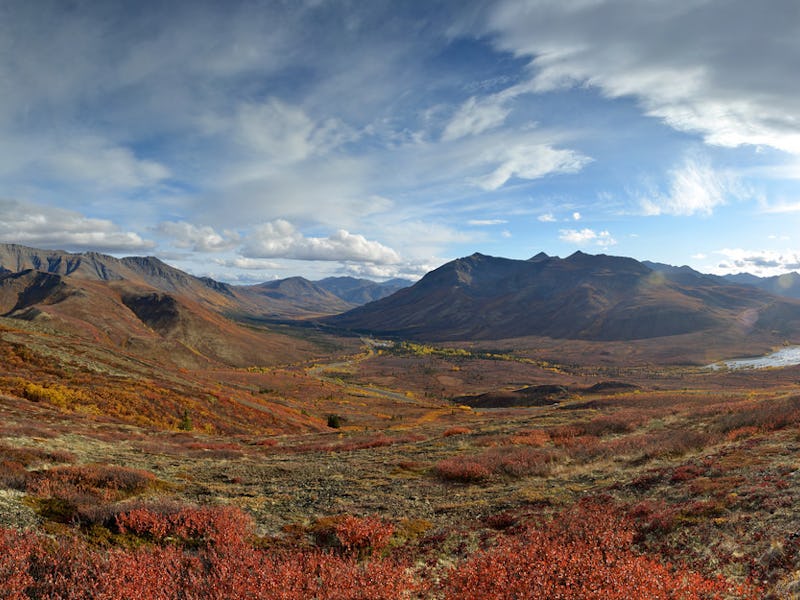Canada's Dempster Highway Arctic Ocean Extension Was Built for Oil, Road Trips
The road was conceived as a subsidy to oil companies, but you should use it to subsidize your next big adventure.

Two construction crews in Canada’s Far North just became one construction crew when they met in the middle of the long extension being built from the Dempster Highway to the Arctic Ocean. The completed road, is the countries’ first throughway to the Arctic Ocean and though it will never serve the purpose for which it was built, it may become a fascinating new destination for adventure travelers.
Specifically, the road, which will open later this year, links Tuktoyaktuk (pop. 900), to the regional center of Inuvik, population 3,500, year-round. Today, the communities are linked only during the winter months, when an ice road over the frozen Mackenzie River is possible.
While the road will cut living expenses and potentially provides new economic opportunities for residents of Tuktoyaktuk — it was not imagined primarily for their benefit. Instead, Canada’s oil-happy former prime minister, Stephen Harper, pushed the project as a way to expedite the promised Arctic resource boom. One exploration company working in the area estimated that its costs would drop 15 percent, meaning the highway could have represented a significant subsidy. That said, it doesn’t — at least not for the moment.
The dream of an Arctic black-gold rush is currently on hold, if not abandoned altogether. Shell’s lack of success in exploratory drilling efforts, coupled with the plunge in oil prices, have killed interest in the area for the foreseeable future. Maybe prices will rebound, and enthusiasm will return, but only if the planet shuts its collective ears and eyes to the growing threat of climate change. Canada’s new prime minister, Justin Trudeau, has promised not to do that.
What will be the legacy of this $300 million, two-lane gravel highway? For locals, it could bring both pain and opportunity. The road that gives access to jobs also makes it easier for alcohol and drugs, which often wreak havoc in such communities. But while resource jobs come and go with the whims of global markets, its all but guaranteed that the road will bring more summer tourists to tiny Tuktoyaktuk.
The new road means big changes for residents of the tiny Arctic coastal town of Tuktoyaktuk.
Already, the Dempster Highway is a popular trip for RVers and road warriors wanting to test their mettle on one of the most remote highways on the planet. The current road travels 460 miles from Dawson City, Yukon, up through isolated mountain ranges and river valleys, to Inuvik, Northwest Territories. The road is famous for washouts and potholes that slow traffic to barely a crawl. It���s not hard to imagine that tourists would be willing to push on another 75 miles for a chance to dip their toes in the Arctic Ocean.
Arctic oil exploration may have fizzled, but Arctic tourism is booming. The lack of summer ice is allowing bigger and bigger cruise ships to ply the waters of the Northwest Passage, and wealthy explorers are forking out tens of thousands of dollars for the privilege.
A road to the top of the world.
Access by road is will be considerably more affordable, and well worth the trip. The Dempster Highway begins in an area steeped in Gold Rush history, where the scars of dredged creek beds mark the landscape like enormous slithering snakes. Before long, though, you’re in Tombstone Territorial Park, an incredible expanse of wilderness marked by ragged mountain peaks that appear to grow up from the weathered, ancient landscape.
Continue North and you’ll hit Eagle Plains, a “town” that counts only a handful of permanent residents — all either highway maintenance workers or employees of the hotel and gas station that provide the only services on the highway for 350 miles.
Welcome to the Arctic Circle.
A little further and you’ll pull over to take a picture at a highway pull-off with a signpost that marks your entry into the Arctic Circle — the land of perpetual darkness and never-setting sun. After you summit the Richardson Mountain range and pass the border in the Northwest Territories, you’ll descend into the Mackenzie River Valley and its braided, snaking channels that carry water that fell as rain thousands of miles away to Arctic seas. You’ll cross rivers twice by ferry, and stop in tiny Gwich’in and Inuvialuit communities, where locals will tell you stories as old as the mountains, if you’re willing to listen.
After Inuvik, you’ll be on the new section of the highway, long-dubbed the Road to Resources. The relevant resource now? Natural beauty. And there’s no need to drill for it.